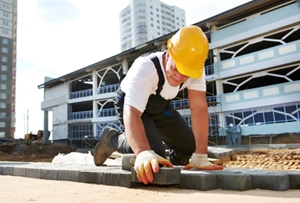Opening the Keys of Lasting Masonry Building Practices for Eco-Friendly Structures
In the realm of modern-day construction, the pursuit of lasting techniques has ended up being paramount. Amongst the myriad techniques to environment-friendly structure, sustainable masonry construction attracts attention as a reliable and sturdy technique that holds a wide range of untapped possibility. From the choice of materials to innovative construction strategies, the keys to accomplishing sustainability within stonework building are diverse and interesting. By exploring the benefits, products, strategies, and future patterns of lasting stonework, a deeper understanding of exactly how these methods can form the future of green structures arises.
Benefits of Sustainable Masonry Construction
Accepting sustainable stonework building practices not only minimizes environmental influence but additionally uses lasting financial advantages to builders and areas. By using products like recycled bricks, obstructs, and rocks, building contractors can significantly lower the carbon footprint of their jobs while promoting source efficiency. Furthermore, sustainable masonry building strategies, such as correct insulation and thermal mass buildings, can improve power effectiveness within buildings, resulting in lowered functional prices with time.
Additionally, the resilience and durability of masonry frameworks add to lasting financial advantages. Buildings created utilizing sustainable stonework practices typically call for much less repair and maintenance, translating to cost financial savings for home builders and property owners. The long life of masonry materials also ensures that frameworks stay steady and secure, lowering the demand for constant restorations or substitutes.
Eco-Friendly Stonework Materials
Using environmentally friendly masonry materials is a pivotal step towards improving the sustainability of construction techniques and lessening ecological effect while taking full advantage of long-term economic benefits. Sustainable stonework materials are sourced, produced, and used in a fashion that lowers overall environmental impact. Products such as recycled blocks, recovered rock, and lasting cinder block are coming to be progressively popular selections for eco-conscious contractors. Recycled blocks, as an example, not just draw away waste from landfills but likewise need much less energy to produce compared to new bricks. Recovered rock offers a special aesthetic allure while decreasing the requirement for new quarrying. Lasting concrete obstructs incorporate recycled accumulations and might include improved insulation residential or commercial properties, contributing to energy performance in structures.
Furthermore, natural products like adobe, rammed planet, and straw bales offer excellent thermal mass properties, minimizing the demand for heating and cooling power. These products are frequently in your area offered, advertising regional economic situations and lowering transportation-related carbon exhausts. By selecting environment-friendly stonework products, building jobs can significantly minimize their ecological impact and add to the production of my site much healthier, extra sustainable developed atmospheres.
Energy-Efficient Masonry Techniques
Power performance plays an essential function in improving the sustainability of masonry building and construction techniques. One vital energy-efficient stonework strategy is the use of thermal mass, which entails integrating dense products like concrete or brick into the structure's structure to absorb and keep warmth.

Advancements in Lasting Stonework
Recent innovations in lasting stonework techniques have produced innovative techniques that are improving the building market. One such development is the advancement of self-healing concrete, which utilizes bacteria embedded within the concrete to heal fractures autonomously. This advancement not just lowers upkeep costs yet additionally enhances the resilience of masonry structures, adding to their sustainability.
An additional notable technology is the usage of recycled aggregates in stonework building and construction - masonry contractor. By incorporating products such as smashed ceramic waste or recycled glass right into concrete mixes, building contractors can reduce the environmental impact of building projects while keeping structural stability. This practice not just diverts waste from landfills but additionally saves natural deposits, making it a key advancement in lasting stonework construction
In addition, the assimilation of electronic design devices, such as Structure Information Modeling (BIM), visite site is revolutionizing the method masonry frameworks are planned and created. BIM allows for more precise estimations, minimized product wastage, and boosted energy performance, eventually causing even more lasting building methods. These innovations collectively signify an encouraging future for lasting masonry building in the period of green buildings.
Future Trends in Stonework Sustainability
With the ingenious strides made in lasting masonry practices, the future patterns in stonework sustainability are positioned to further reinvent the construction sector. One of the key trends shaping the future of masonry sustainability is the boosted combination of innovation. Improvements such as Structure Details Modeling (BIM) and virtual reality simulations are being made use of to optimize masonry building and construction procedures, resulting in lowered material waste and improved power effectiveness in buildings.
Additionally, the advancement of unique lasting materials is established to play a considerable role in improving the eco-friendliness of masonry building. masonry contractor. Innovations like self-healing concrete, recycled accumulations, and bio-based binders are getting grip for their capacity to decrease environmental effect while keeping structural stability

Conclusion
In final thought, sustainable stonework building and construction techniques provide various advice advantages for eco-friendly buildings. By utilizing green products and energy-efficient methods, masonry can contribute to a more lasting built setting. Innovations in sustainable masonry are continually being established to further boost the ecological efficiency of structures. Looking towards the future, the fad of masonry sustainability is expected to grow, resulting in more eco-friendly and energy-efficient building practices in the years to find.